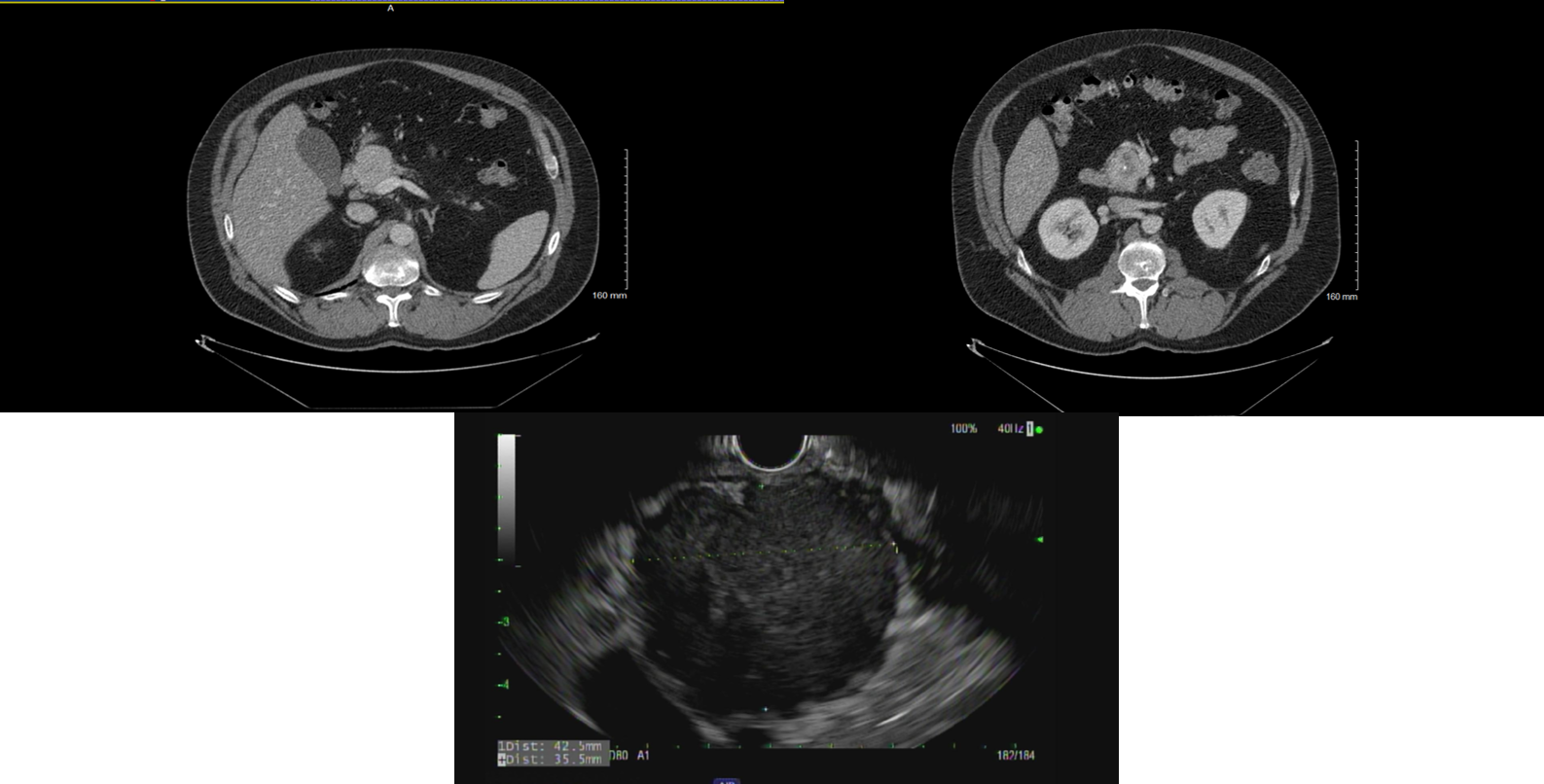Sunday Poster Session
Category: Biliary/Pancreas
P0229 - Pancreatic Mass as a Rare Recurrence of Synovial Sarcoma: A Case Report
Sunday, October 26, 2025
3:30 PM - 7:00 PM PDT
Location: Exhibit Hall

Francis Asino, MS, BS
Touro University California, College of Osteopathic Medicine
Vallejo, CA
Presenting Author(s)
Francis Asino, MS, BS1, Quynh Ton, BS2, Amanpal Singh, MD3
1Touro University California, College of Osteopathic Medicine, Vallejo, CA; 2Touro University California, Clovis, CA; 3Mercy Medical Group, Carmichael, CA
Introduction: Synovial sarcoma (SS) is a rare, aggressive soft tissue malignancy typically arising in the lower extremities of young adults. Over 50% of patients have recurrence within two years, most commonly to the lungs, lymph nodes, or bone. Pancreatic metastasis is extremely rare, with only a few reported cases. We present a case of biphasic SS arising in the right thigh, which recurred as a solitary pancreatic metastasis in a 55-year-old man after an extended disease-free interval.
Case Description/
Methods: A 55 year-old-man with a history of stage IIIB biphasic synovial carcinoma of the right thigh underwent neoadjuvant radiation and surgical resection without adjuvant chemotherapy. Surveillance imaging included CT chest every 3 months and MRI femur every 6 months, with stable subcentimeter pulmonary nodules and no evidence of recurrence or metastasis. He underwent CT scan of the chest for surveillance imaging after a four year disease-free interval, which revealed a large pancreas head mass.
Abdominal CT revealed a mass in the pancreatic head and uncinate process, possibly involving the portal and mesenteric veins. Subsequent endoscopic ultrasound showed two irregular, hypoechoic pancreatic masses in the head and a hypoechoic well rounded mass in the tail. Fine needle biopsy confirmed malignant cells consistent with SS in the pancreatic head and tail. FISH analysis demonstrated SS18 (SYT) rearrangement, confirming metastatic SS.
Discussion: In this case report, the patient’s asymptomatic presentation and absence of prior metastatic disease to common sites such as the lungs lowered clinical suspicion. Standard surveillance for extremity soft tissue sarcomas (eSTS) focusemetastasectomyite and chest imaging. This case highlights the potential value of incorporating abdominal imaging into long-term follow-up, even in asymptomatic patients, given the possibility of rare metastatic spread.
Prognosis varies based on metastatic burden, resection completeness, and systemic therapy response. Solitary lesions may have better outcomes, as seen in a case report with three years of recurrence-free survival. In contrast, another case report described rapid progression and death within two months with lung metastases. In addition, poorly differentiated SS (PDSS) carries a higher risk of recurrence and worse outcomes; one patient with PDSS died three months after extrapleural pneumonectomy. These findings underscore the need for more research on pancreatic SS metastasectomy, particularly in high-risk subtypes.

Figure: Figure: Axial contrast-enhanced CT abdomen (top) and corresponding endoscopic ultrasound (EUS) image (bottom) of the pancreatic head.
Disclosures:
Francis Asino indicated no relevant financial relationships.
Quynh Ton indicated no relevant financial relationships.
Amanpal Singh indicated no relevant financial relationships.
Francis Asino, MS, BS1, Quynh Ton, BS2, Amanpal Singh, MD3. P0229 - Pancreatic Mass as a Rare Recurrence of Synovial Sarcoma: A Case Report, ACG 2025 Annual Scientific Meeting Abstracts. Phoenix, AZ: American College of Gastroenterology.
1Touro University California, College of Osteopathic Medicine, Vallejo, CA; 2Touro University California, Clovis, CA; 3Mercy Medical Group, Carmichael, CA
Introduction: Synovial sarcoma (SS) is a rare, aggressive soft tissue malignancy typically arising in the lower extremities of young adults. Over 50% of patients have recurrence within two years, most commonly to the lungs, lymph nodes, or bone. Pancreatic metastasis is extremely rare, with only a few reported cases. We present a case of biphasic SS arising in the right thigh, which recurred as a solitary pancreatic metastasis in a 55-year-old man after an extended disease-free interval.
Case Description/
Methods: A 55 year-old-man with a history of stage IIIB biphasic synovial carcinoma of the right thigh underwent neoadjuvant radiation and surgical resection without adjuvant chemotherapy. Surveillance imaging included CT chest every 3 months and MRI femur every 6 months, with stable subcentimeter pulmonary nodules and no evidence of recurrence or metastasis. He underwent CT scan of the chest for surveillance imaging after a four year disease-free interval, which revealed a large pancreas head mass.
Abdominal CT revealed a mass in the pancreatic head and uncinate process, possibly involving the portal and mesenteric veins. Subsequent endoscopic ultrasound showed two irregular, hypoechoic pancreatic masses in the head and a hypoechoic well rounded mass in the tail. Fine needle biopsy confirmed malignant cells consistent with SS in the pancreatic head and tail. FISH analysis demonstrated SS18 (SYT) rearrangement, confirming metastatic SS.
Discussion: In this case report, the patient’s asymptomatic presentation and absence of prior metastatic disease to common sites such as the lungs lowered clinical suspicion. Standard surveillance for extremity soft tissue sarcomas (eSTS) focusemetastasectomyite and chest imaging. This case highlights the potential value of incorporating abdominal imaging into long-term follow-up, even in asymptomatic patients, given the possibility of rare metastatic spread.
Prognosis varies based on metastatic burden, resection completeness, and systemic therapy response. Solitary lesions may have better outcomes, as seen in a case report with three years of recurrence-free survival. In contrast, another case report described rapid progression and death within two months with lung metastases. In addition, poorly differentiated SS (PDSS) carries a higher risk of recurrence and worse outcomes; one patient with PDSS died three months after extrapleural pneumonectomy. These findings underscore the need for more research on pancreatic SS metastasectomy, particularly in high-risk subtypes.

Figure: Figure: Axial contrast-enhanced CT abdomen (top) and corresponding endoscopic ultrasound (EUS) image (bottom) of the pancreatic head.
Disclosures:
Francis Asino indicated no relevant financial relationships.
Quynh Ton indicated no relevant financial relationships.
Amanpal Singh indicated no relevant financial relationships.
Francis Asino, MS, BS1, Quynh Ton, BS2, Amanpal Singh, MD3. P0229 - Pancreatic Mass as a Rare Recurrence of Synovial Sarcoma: A Case Report, ACG 2025 Annual Scientific Meeting Abstracts. Phoenix, AZ: American College of Gastroenterology.
